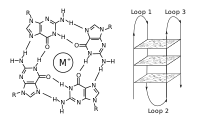
Photo from wikipedia
Abstract The hexanucleotide repeat expansion, GGGGCC (G4C2), within the first intron of the C9orf72 gene is known to be the most common genetic cause of both amyotrophic lateral sclerosis (ALS)… Click to show full abstract
Abstract The hexanucleotide repeat expansion, GGGGCC (G4C2), within the first intron of the C9orf72 gene is known to be the most common genetic cause of both amyotrophic lateral sclerosis (ALS) and frontotemporal dementia (FTD). The G4C2 repeat expansions, either DNA or RNA, are able to form G-quadruplexes which induce toxicity leading to ALS/FTD. Herein, we report a novel crystal structure of d(G4C2)2 that self-associates to form an eight-layer parallel tetrameric G-quadruplex. Two d(G4C2)2 associate together as a parallel dimeric G-quadruplex which folds into a tetramer via 5′-to-5′ arrangements. Each dimer consists of four G-tetrads connected by two CC propeller loops. Especially, the 3′-end cytosines protrude out and form C·C+•C·C+/ C·C•C·C+ quadruple base pair or C•C·C+ triple base pair stacking on the dimeric block. Our work sheds light on the G-quadruplexes adopted by d(G4C2) and yields the invaluable structural details for the development of small molecules to tackle neurodegenerative diseases, ALS and FTD.
Journal Title: Nucleic Acids Research
Year Published: 2021
Link to full text (if available)
Share on Social Media: Sign Up to like & get
recommendations!